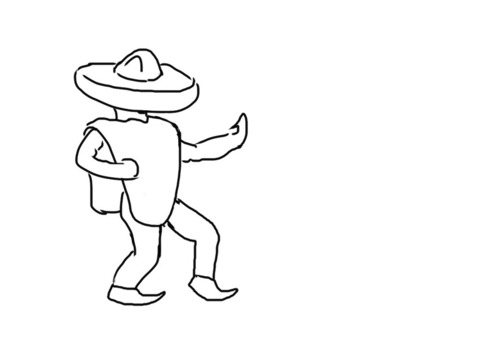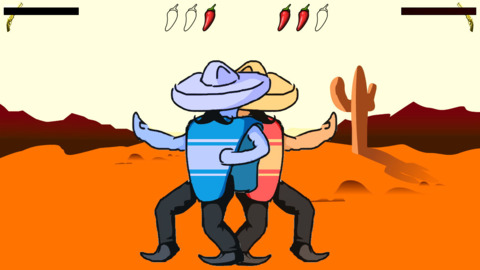Playing Footsies With Fighting Games
Two buttons, two kicks, and two banditos. Luke Esquivel explains how his indie fighter Senor Footsies is reimagining fighting games with minimalist design.
Under the blazing sun of a nameless desert, two poncho-wearing banditos square off in mortal combat. They do not fight with guns or knives, only kicks. One kick, one kill. Two men enter, one man--well, you get the idea. This is the simplicity of Senor Footsies.
Described as an "instantly learnable fighting game" by its creator, Luke "A-Rival" Esquivel, this game distills the conventional fighting formula down to one of its fundamentals: spacing. It's a simple, fast-paced game that bucks the trend of an increasingly mechanics-heavy genre.
STAR WARS: Prequel Pack - Official Reveal Trailer DEAD OR ALIVE Xtreme Venus Vacation PRISM - Official 2nd Trailer Phantom Blade Zero - 6 Minute "Year of the Snake" Gameplay Trailer The Hundred Line -Last Defense Academy-: Character Trailer 1 Black Ops 6 & Warzone - Official Season 02 Launch Trailer GUILTY GEAR STRIVE: DUAL RULERS - Official Main Trailer Marvel Rivals | The Spring Festival Trailer Kingdom Come: Deliverance 2 Roadmap Trailer Zenless Zone Zero - Astra Yao Character Demo | "Ridu Holidays" BlazBlue Entropy Effect - Hazama Character DLC Gameplay Reveal Trailer Helskate Launch Trailer Code Violet | Announcement Trailer
Please enter your date of birth to view this video
By clicking 'enter', you agree to GameSpot's
Terms of Use and Privacy Policy
The spark for Senor Footsies came to Esquivel after brainstorming ideas with members of the fighting game community at IPLAYWINNER. A musician and hobbyist game developer, Esquivel has grown dissatisfied with the way some modern fighters are being developed. As precedence is given to larger, deadlier combos, he feels the more interesting aspects of fighting are being overshadowed. And he is not alone.
Senor Footsies may remind you of another two-button fighter, Adam Heart's Divekick. While the two share several similarities, their play styles are completely different. Divekick is an air-to-air fighter about reading trajectory. In Senor Footsies there is no jumping, only ground-based combat. Esquivel noted that this style of fighting is something a lot of newcomers--and some veterans--try hard to avoid. But the ground game is unavoidable, and Senor Footsies is here to help.


HOW IT WORKS
Senor Footsies is played with two buttons: walk and kick. By default, your character walks backward; holding the walk button will move him forward. This was an idea Esquivel had in place from the very beginning. "At first it was [the opposite], but I liked the idea of having to commit to moving forward," he said. Doing so makes the game feel more aggressive by putting you in control of an offensive, rather than defensive, action.
The kick button alone performs a simple low kick that doesn't reach very far but strikes fast. While it would destroy your knees in real life, this is your rapid-fire, go-to attack. Now, if you're feeling bold, pressing the move and kick buttons together performs a low roundhouse. This attack reaches farther but takes longer to recover from, making it more risky.
This two-attack system may sound simple enough, but there's one small quirk. The sweep actually loses to the kick when they collide at maximum range. A peek under the hood reveals that the sweep's hitbox--the area of the attack that can actually hurt you--rests flush against its hurtbox--the area that can actually be hit. Meanwhile, the kick's hitbox sticks out a bit away from the hurtbox. When the tips of the two moves collide, the kick wins since it has that small buffer area.
But enough about boxes; there's one other factor to manage: the pistol. When you can use the pistol is determined by an energy meter that slowly fills as you miss attacks. That's right, like so many other fighters, Senor Footsies has an energy meter, but its function is different from most. Instead of filling the screen with colorful lasers and double-digit combos, you cash in the meter to fire the pistol--performed by holding and releasing the kick button--which momentarily stuns your opponent.
"I like meter management. It helps add depth without making the controls too complicated," Esquivel said. The meter also helps push the action forward by rewarding you for being aggressive. Of course, it has some limitations. The pistol shot will miss if the target is walking backward. In addition, once the meter is full, it will stay that way for only a short time. This way one player will not remain in a dominant position forever.
Despite such simple designs, Senor Footsies remains very exciting. The energy felt from a nail-biter match, where everything comes down to a pixel, is reproduced round after round. All the long, technical combos have been washed away. It is a game of simple pleasures, and it exposes how there is still room in the fighting genre for experimentation.
THE MASTER OF FOOTSIES
Growing up, Esquivel has cast a wide net creatively. Performers such as The Crystal Method and Prodigy drove him toward a passion for music early in life, leading him to produce several personal compositions, as well as collaborate on the Super Street Fighter II Turbo HD Remix soundtrack. He was even part of a high school breakdancing troupe--alongside his brother, James (a.k.a. "Jimmy Hits")--that performed across California, so you know the man has style.
Despite having no formal training in coding, Esquivel was able to take Senor Footsies from concept to playable demo in just two days. What coding experience he has is self-taught from school projects in his free time.
After graduating from high school, Esquivel happened upon Capcom's IRC channel. Flush from numerous victories over the local competition in Street Fighter III: 3rd Strike, he brazenly challenged another hotshot, Alex Valle, now president of Level|Up Series. The showdown took place at the Battle by the Bay 2001, the precursor to EVO. Naturally, Esquivel was destroyed.
"It was an eye-opening experience," he admitted. "I mean, back then we didn't have live streams, so I didn't know there was this whole hardcore community around [fighting games]. After that tournament, I knew I was hooked."
Today, Esquivel keeps his talents alive through game development, the upcoming release of his album Super Square, and his job as a lead developer with Knack.it. And he has plenty more plans for Senor Footsies. For one, he wants to move from the hand-drawn, 2D version to a 3D version reminiscent of Street Fighter IV. This means tapping the talents of friend and artist Gordon Henson. "[Gordon] can do everything. He taught himself how to draw, and later model, and it has been really cool watching him develop over the years."
STAR WARS: Prequel Pack - Official Reveal Trailer DEAD OR ALIVE Xtreme Venus Vacation PRISM - Official 2nd Trailer Phantom Blade Zero - 6 Minute "Year of the Snake" Gameplay Trailer The Hundred Line -Last Defense Academy-: Character Trailer 1 Black Ops 6 & Warzone - Official Season 02 Launch Trailer GUILTY GEAR STRIVE: DUAL RULERS - Official Main Trailer Marvel Rivals | The Spring Festival Trailer Kingdom Come: Deliverance 2 Roadmap Trailer Zenless Zone Zero - Astra Yao Character Demo | "Ridu Holidays" BlazBlue Entropy Effect - Hazama Character DLC Gameplay Reveal Trailer Helskate Launch Trailer Code Violet | Announcement Trailer
Please enter your date of birth to view this video
By clicking 'enter', you agree to GameSpot's
Terms of Use and Privacy Policy
3D models will also allow for more complex animations, including a Matrix-style dodge when a pistol shot misses. Other ideas for the game include an X-Factor-style mechanic dubbed "JalapenYOLO." If you hold both buttons at the start of a round, your character will turn red and become faster for that round. The more rounds you have previously lost in the set, the faster you become. But this technique only has one use, so if you don't get the kill then, well, you've just wasted it.
Additional characters are also in the works. "When I eventually add new characters, I want them all to have different weapons," Esquivel said. One example is a female character who fires a projectile that can be dodged by timing your low kick to duck beneath it. Another is a fighter using a mechanical arm that targets a specific area of the screen.
"That's the funny thing. In the beginning this game wasn't going to be a serious project, but now it has turned into a full-fledged project. And now that the game is in the Unity game engine, I can port it to iPhone, iPad, Android, Xbox 360, or PS3 if I want to. It would be cool to make some money off of it, but honestly this is just for fun."
BACK TO BASICS
Senor Footsies, as well as Divekick, arrives in response to an increasingly complex fighting genre. Initially, Esquivel did not enjoy Street Fighter IV's return to basics (a design strategy seemingly ignored by its competitors), but he has since grown to appreciate it. "At first I hated Street Fighter IV, and there are still some things I don't agree with, but they stripped out a lot of the unnecessary [mechanics] and went back to roots. The give-and-take is what's really important. I like that."
A lot of developers [include] attacks with no downsides. I think downsides are what make things beautiful as they allow for interesting interaction."A lot of developers will [include] attacks with no downsides. I think the downsides are what make things beautiful because they allow for interesting interaction. If an attack is super good, you will just use that attack all the time. You saw this a lot in the first Marvel vs. Capcom 3. That game had a lot of really powerful attacks with no downsides, and those made the game less interesting."
With every sequel, Esquivel feels that "feature creep" is taking hold. As new mechanics create larger, deadlier combos, many fighting games are losing one of their most exciting aspects: mind games.
Longer, flashier combos are not the answer. What interests Esquivel are the split-second situations that precede long combos. Those do-or-die moments, when one fighter breaks past the opponent's defenses, are the real entertainment. "Finding the window [for a combo] is the most exciting part, and the simpler your game is, the easier it is to see that happen."
"I think [some developers] are trying to take a step back, but their execution is off. Persona 4 Arena does a good job of this. You can perform extended combos in that game, but you have to pay a lot of meter. It doesn't feel like a sit-and-wait combo game. I don't like the trend toward touch-of-death combos. I like short combos that lead into interesting situations."
Of course, he is quick to acknowledge the merits of technical proficiency in fighting games, just within reason. "In Marvel you get hit by a combo and then you just have to sit there and wait. I've seen guys stop and check their phones during long combos, at tournaments."

Esquivel still has a long way to go with his game, and the end is certainly not in sight. A few days before this post, he had just finished polishing off the game's shiny new HUD, seen above. He also teased another major update that he wasn't quite ready to reveal. As his project grows in size and scope, it is exciting to see how Senor Footsies will resonate within the fighting community, and what lessons other developers will take away from this less-is-more approach.
Thanks to Haunts at IPLAYWINNER for supplying A-Rival's contact information. You can follow A-Rival on Twitter via @8bitpimp or on his personal blog.
Got a news tip or want to contact us directly? Email news@gamespot.com



Join the conversation